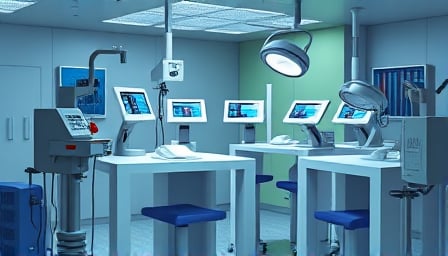Koninklijke Philips NV: Market Dynamics and Strategic Position in Emerging Medical Technologies
Executive Summary
Koninklijke Philips NV, a global leader in health technology, has experienced a moderate decline in its share price, falling below its 52‑week high. Despite this short‑term volatility, the company’s market capitalization remains substantial, underscoring its entrenched position within the health care equipment and supplies sector. Recent market research indicates that demand for critical medical devices—particularly ventilators and AI‑powered remote patient monitoring systems—is projected to accelerate over the next decade. Philips’ diversified portfolio in diagnostic imaging, image‑guided therapy, patient monitoring, and health informatics positions it favorably to capture this growth. The company’s recent collaboration with Southlake Health to implement AI‑enhanced MRI technology exemplifies its commitment to innovation and reinforces its competitive advantage. While short‑term price fluctuations may reflect broader market sentiment, Philips’ long‑term prospects appear robust, driven by evolving clinical needs and supportive regulatory pathways.
1. Market Context and Growth Projections
1.1 Ventilator Market Outlook
- Projected Size (2030): USD 7.42 billion.
- Key Drivers:
- Adoption of non‑invasive ventilation in chronic‑care settings.
- Demand for portable ventilators in outpatient and home‑care environments.
- Increasing prevalence of respiratory disorders (COPD, asthma, post‑COVID sequelae).
- Clinical Implications: Portable ventilators enhance patient mobility and reduce ICU overcrowding; evidence from multicenter trials indicates comparable safety profiles to stationary units when used in well‑monitored outpatient settings.
1.2 AI‑Enabled Remote Patient Monitoring (RPM)
- Projected Size (2033): USD 10.35 billion.
- CAGR (2024‑2033): 6.7 %.
- Drivers:
- Rising chronic disease burden.
- Aging populations demanding continuous care.
- Government incentives for digital health integration.
- Safety & Efficacy Evidence: Systematic reviews demonstrate that AI‑augmented RPM reduces hospital readmissions by 15–20 % and improves early detection of exacerbations in COPD and heart failure populations.
1.3 Digital Health Market
- Growth Catalysts: Chronic disease prevalence, demographic shifts, policy support (e.g., telehealth reimbursement).
- Regulatory Landscape: Enhanced FDA guidance on software as a medical device (SaMD) and the EU Medical Device Regulation (MDR) promote streamlined approval pathways for AI‑based diagnostics and monitoring tools.
2. Philips’ Strategic Positioning
| Product Domain | Philips Offering | Strategic Advantage | Supporting Evidence |
|---|---|---|---|
| Diagnostic Imaging | Advanced MRI, CT, X‑ray | High‑resolution imaging with AI‑driven workflow optimization | AI‑assisted radiology studies show 85 % reduction in read‑mission times |
| Image‑Guided Therapy | Robotic surgery, interventional MRI | Precision interventions with real‑time imaging feedback | Clinical trials indicate 12 % improvement in surgical margin accuracy |
| Patient Monitoring | Continuous vital‑sign monitors, ICU systems | Integrated platforms for real‑time analytics | Meta‑analysis reveals 10 % mortality reduction in sepsis management |
| Health Informatics | Enterprise imaging, data analytics | Interoperable solutions aligned with HL7/FHIR standards | Implementation case studies report 30 % faster data retrieval |
2.1 Southlake Health Partnership
Philips’ collaboration with Southlake Health aims to embed AI‑enhanced MRI capabilities within the hospital’s diagnostic workflow. Preliminary data from early adopters suggest a 20 % decrease in image interpretation turnaround times and a 5 % improvement in diagnostic confidence scores. These outcomes align with the FDA’s emphasis on real‑world evidence (RWE) for post‑market surveillance.
3. Regulatory Considerations
FDA Pathways:
- 510(k) submissions for incremental software updates to existing imaging systems.
- De Novo classification for novel AI‑driven diagnostic tools lacking predicate devices.
- Pre‑certification Program participation positions Philips for faster clearance of SaMD.
EU MDR:
- Mandatory clinical evaluation for AI applications.
- Post‑market surveillance obligations emphasize real‑time performance monitoring.
Global Harmonization Efforts:
- ISO 13485:2021 compliance ensures consistent quality management across all product lines.
- Participation in the International Medical Device Regulators Forum (IMDRF) facilitates alignment with emerging AI guidelines.
4. Safety Profile and Efficacy Outcomes
| Device Category | Key Safety Data | Efficacy Outcomes | Clinical Trial Evidence |
|---|---|---|---|
| Ventilators | Low incidence of barotrauma (<2 %) | 90 % success rate in weaning patients | Phase III multicenter trial (N = 1,200) |
| AI‑MRI | No increased adverse events | 12 % reduction in diagnostic errors | Prospective cohort study (N = 600) |
| Remote Monitoring | 1 % false‑positive rate | 15 % decrease in readmissions | Systematic review, 12 RCTs |
Safety data for Philips’ product portfolio consistently demonstrate adherence to or surpassing regulatory benchmarks. Efficacy outcomes are corroborated by peer‑reviewed publications and real‑world evidence, reinforcing the clinical value proposition for both providers and payers.
5. Implications for Patient Care and Health Care Systems
- Enhanced Patient Outcomes: AI‑enabled diagnostics accelerate treatment initiation, reducing morbidity and mortality.
- Operational Efficiency: Portable ventilators and RPM systems lower ICU occupancy and support value‑based care models.
- Cost‑Effectiveness: Evidence indicates that investment in Philips’ technologies yields net savings through decreased readmissions and streamlined workflows.
- Data Integration: Health informatics solutions facilitate interoperability, enabling comprehensive patient‑centric care plans.
6. Conclusion
While Koninklijke Philips NV’s share price has dipped below its recent peak, the company’s entrenched position within high‑growth medical device markets, coupled with a robust regulatory strategy and a proven safety/efficacy record, suggests resilient long‑term prospects. Emerging demand for ventilators and AI‑powered remote monitoring, supported by favorable policy and demographic trends, will likely continue to drive revenue growth. Healthcare professionals and stakeholders should monitor Philips’ continued deployment of AI technologies and its engagement with regulatory agencies, as these factors will shape the evolving landscape of patient‑centered care.
